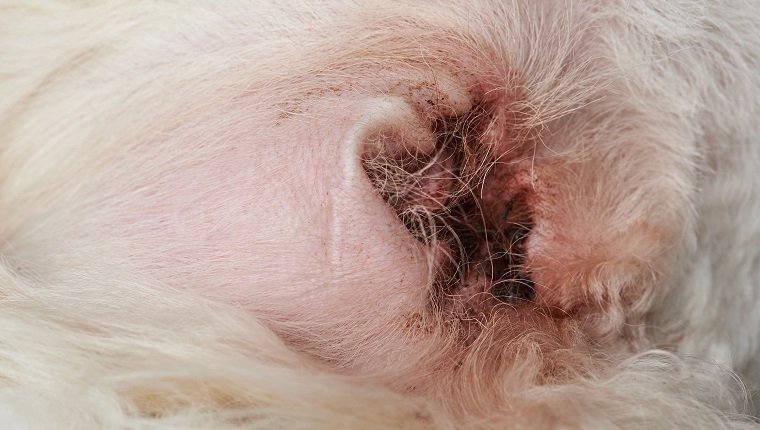Yeast infections in dogs are fungal infections that can affect the urinary tract, mouth, or skin, especially the skin on the ears, paws, armpits, and around skin folds or wrinkles. The ears are the parts of dogs’ bodies that most often show signs of yeast infections.
Fungal yeasts exist in and on dogs’ bodies naturally and usually aren’t a problem. However, there are many things that can cause overgrowth of yeast, including medical conditions, exposure to medications, or weakened immune systems.
Malassezia pachydermatitis is the type of yeast that overgrows and causes skin and ear infections. Candida yeasts affect the digestive system, mouth, and genital areas. They’re also responsible for the mouth and tongue condition known as thrush.
Yeast infections can lead to discomfort, self-inflicted injuries, and further infections among other issues. If you see signs of a yeast infection in your dog, then you must consult your veterinarian for a diagnosis and treatment. Here’s what you should know about the symptoms, causes, and treatments for yeast infections in dogs.
Symptoms Of Yeast Infections In Dogs

The symptoms of yeast infections in dogs often depend on which part of the body is infected.
Usually they occur in the urinary tract, in the mouth, or on the skin. With all of these infections, signs of pain or discomfort are common.
Here are a few signs that your dog may be suffering from a yeast infection of the urinary tract:
- Cloudy or bloody urine
- Urine has foul odor
- Signs of pain or straining while urinating
- Signs of discomfort around the genitals or bladder
- Accidents in the house
- Lethargy
- Loss of appetite
- Nausea
Here are some signs of a yeast infection in a dog’s mouth:
- Bad breath
- Drooling
- Signs of pain around the mouth
- Difficulty eating
- White coating on the mouth or tongue (known as thrush)
Here are a few common symptoms of a yeast infection on a dog’s skin, which often appear on the ears, paws, or near the genitals:
- Chewing, licking, or scratching at infected areas
- Head shaking (with ear infections)
- Bad odor from infected areas
- Alopecia
- Redness or inflamed skin
- Greasy, crusty, or scaly skin
- Oily hair
- Open sores
- Self-inflicted wounds
- Secondary infection
- Behavioral changes (anxiety, aggression, depression, etc.)
Causes Of Yeast Infections In Dogs

There are many factors that can cause fungal yeasts, which occur normally in and on dogs’ bodies, to overgrow and lead to yeast infections in dogs.
This can happen to dogs of any age, breed, or sex, though some breeds are predisposed to yeast infections. These include Basset Hounds, Chinese Shar-Peis, Cocker Spaniels, Dachshunds, German Shepherd Dogs, Poodles, Shih Tzus, and West Highland White Terriers.
Here are some other factors that can cause yeast infections in dogs:.
- Exposure to medications such as antibiotics or corticosteroids
- Diabetes
- Improper diet
- Weakened immune system
- Exposure to hot, humid weather
- Bites or allergies to fleas, ticks, mites, or parasites
- Food allergies
- Cushing’s disease, Addison’s disease, or other endocrine disorders
- Chemotherapy
- Use of a medical catheter
- Skin irritation or infection
Treatments For Yeast Infections In Dogs

Treatment for yeast infections in dogs depends on many factors, including the location of the infection, the severity, the type of yeast, and any underlying causes that may lead to yeast overgrowth.
Sometimes treating the cause, such as removing allergens or stopping medication, may be enough to fight off the infection. Other times, dogs need further treatment.
Antifungal and anti-yeast medication may be prescribed to treat the infection. For skin infections, topical medications may need to be applied daily or a few times a day. The prescription may also call for treatment to go on for four to seven weeks. This will depend on the affected dog’s specific needs.
If your dog is diagnosed with a yeast infection, then you must follow your vet’s guidelines closely. Don’t discontinue treatment until they instruct you to do so, even if symptoms improve. Stopping treatment early can result in a relapse.
Usually treatment is effective when given for the full duration of the prescription.
Has your dog ever suffered from a yeast infection? How did you treat it? Let us know in the comments below!









